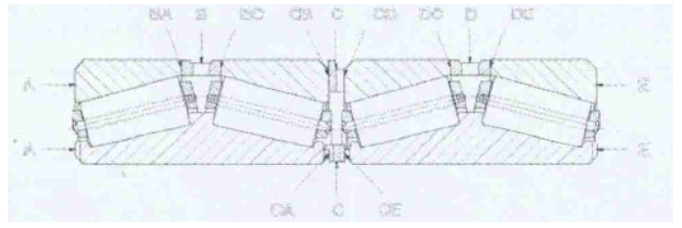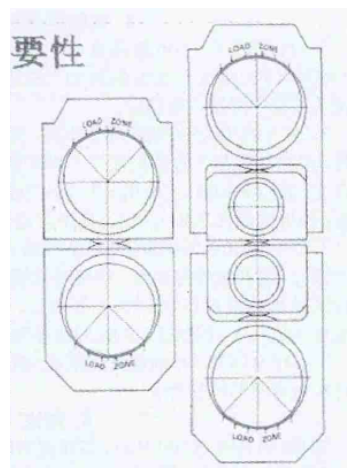
Abstract: This article covers practical information such as how to correctly maintain the bearing housing and bearing assembly, aiming to enhance the performance of the equipment and extend the service life. It mainly includes the following operation guidance.
Key words: tapered roller bearing; Bearing seat; Roll; Bearing area; wear
First. Detailed installation steps (as shown in the figure)

1. Place the "A-BA" outer ring in the bearing seat. Use a feeler to check that the outer ring is fully seated.
2. Place the spacer "B" and operate carefully to avoid scratches or burrs on the spacer.
3. Place the A-side of the double inner ring A-CA face down, and rotate the inner ring to seat the roller.
4. Place the single outer ring BC-CB.
5. Put the outer ring "CD-DC" (DC side up), and then put the outer ring spacer.
6. Put the double inner rings CE-E, E facing up, and rotate the inner rings to seat the rollers.
7. Put in the single outer ring "DE-E" (Note: the position of all the outer ring bearing areas should be consistent.)
Second. Successive steps of bearing maintenance
1. Remove the bearing from the bearing seat
Usually divided into three steps: the first step: take out the top single outer ring and the top double inner ring. Step 2: Take out the double outer ring, bottom double inner ring, inner ring spacer and top outer ring spacer. Step 3: Take out the bottom single outer ring and the bottom outer ring spacer ring.
2. Check bearing parts and components
After the bearing is washed, check the bearing parts with the naked eye for damage or wear. When checking rollers, you need to turn the cage or turn a single roller. Next, take out the roller and check the outer diameter or raceway of the inner ring. If the outer diameter surface of the inner ring or the surface of the roller is found to have small spalling or surface cracks, it is usually possible to carry out simple maintenance of the bearing. All component damage should be recorded. When the outer diameter of the inner ring (raceway) has a large area of spalling so that it cannot support the roller under load conditions, it is not recommended to repair the large area of spalling in this part.
3. Check bearing wear condition
Tapered roller bearings are checked for wear. When measuring the bearing wear degree, the bearing assembly should be stacked and placed on a flat, solid surface after removing the spacer, and the lower outer ring should be supported by the foundation fixing device. The foundation fixture must have machined step holes to allow cage clearance to allow the inner ring assembly to rotate freely. When measuring, heavy objects need to be applied to the bearing to make the bearing components fit each other properly. The weight should be aligned with the outer diameter of the bearing outer ring, and the weight of the weight applied should be approximately equal to the weight of the bearing under test. Whenever the bearing assembly is stacked, the correct stacking order should be followed to ensure correct axial clearance and operating accuracy within the bearing. The bearing can be stacked by an outer ring or an outer ring as the bottom outer ring, and the side of the inner ring with A flange should be placed downward to ensure that the spacer is located in the center of the bearing. Each bearing with a spacer to adjust the internal axial clearance has a serial number, and the same serial number is engraved on each part of the bearing. These parts are not interchangeable. After applying a heavy weight to the bearing, the bearing component should be turned so that the large end face of the roller fits the large guard edge of the inner ring. In order to make the bearing roller and the rib fit well, it is necessary to rotate the bearing considerably. The 0.050mm plug gauge can be inserted into the gap between the large end face of the roller and the large guard edge of the bearing inner ring to test whether the bearing parts fit. Once the clearance of B, D and C is measured, the bearing must not be turned again. When it is determined that the bearing components have been properly fitted to each other, the gaps of B, D and C can be measured, and each gap should be measured four times, each two places 90 degrees apart. Calculate the average of the four measurements to find the width of this gap. The B, D and C spacers are then measured to obtain their widths. For bearings with pre-adjusted internal axial clearance, the width of the spacer is always larger than the corresponding clearance, and the difference between the spacer width and the clearance width is the corresponding internal axial clearance of the two rows of rollers adjacent to the spacer. The degree of wear of various components within a bearing may vary. The internal axial clearance between each set of rollers will also be different. The inner axial clearance of the bearing can be adjusted by regrinding the spacer and changing its width. It is not necessary to regrind the spacer until the wear of the bearing makes its internal axial clearance twice the initial value.
4. Check the bearing seat
The housing shall be thoroughly cleaned and inspected for damage, and the housing bore diameter shall be measured to ensure proper clearance between the housing and the frame window. Measurement of B, D and C clearance to understand the degree of wear, measurement of B, D and C spacer width should be more serious rust or micro-wear on the bearing housing grinding or polishing. Therefore, the bore size and irregularity of the bearing seat should be checked regularly. The bearing outer ring is installed in the bearing housing in a loose fit, and its tolerance is based on the nominal size of the outer diameter of the outer ring. All seals should be inspected and replaced if worn or damaged. And the measurement is recorded. If the bearing housing measurement results are not within the manufacturer's permitted specifications, please contact the manufacturer to discuss possible repair options.
5. Load the bearing into the bearing seat

Tapered roller bearings should be installed in a clean environment free of dust, debris or other contaminants, make sure you have the necessary parts, tools and lubricants on hand, and review records to determine which bearing area to use.
Outer ring bearing area
The recommended bearing area is a 90 degree inner diameter or raceway, i.e. a quarter outer cone. If the outer ring bearing zone is found to be greater than or less than 90 degrees, contact the manufacturer for more detailed guidance. The best time to replace the bearing area is during the bearing inspection, when the new outer ring bearing area should be turned to the designated position of the bearing seat. Be sure to keep a record of this activity. The outer ring should be moved to the new bearing area during each inspection, which can extend the service life of the bearing. After using the four areas once in turn, it is recommended to reverse the bearing parts from the lower side of face A to the lower side of face E while maintaining the correct order of the parts. This alternate use allows the bearing zone to be evenly distributed on each row of rollers, thereby extending the bearing life.
Load the bearing into the bearing seat
A thin layer of lubricant is applied to the inner hole of the bearing housing to reduce micro-wear peeling and corrosion between the outer ring and the inner hole of the bearing housing during bearing operation. First load the bottom outer ring into the bearing seat. Each outer ring must be rotated so that its designated bearing area reaches the desired position. The corresponding outer ring spacer can then be installed. After the bearing is fully loaded into the bearing seat, the conventional refueling device is used to add a certain amount of lubricating oil to achieve the specified oil level.
Select bearing housing cover plate gasket
First, the cover plate is installed without gasket, and the four evenly distributed bolts are evenly tightened until the cover plate is close to the bearing outer ring. Do not tighten the bolt too tightly. Select four adjacent bolt positions to measure the gap between the cover flange and the end face of the bearing seat, and then take its average value, that is, the gap. If cork or a similar compressible material is used for the gasket, the gasket thickness is equal to the gap width plus 25% of the increase to compensate for its compression. If a harder material is used, the thickness of the gasket is equal to the gap width plus an increase of 5% to 10%, and it is confirmed that it has been compressed. If metal gaskets are used, it is recommended that the outer ring pre-top tighten 0.05 to 0.08mm. After the cover plate and gasket are installed, tighten the bolts evenly on the bearing seat to ensure that the outer ring is properly clamped.
6. Install the housing assembly on the roll neck
Care should be taken when sliding the housing onto the roll neck to avoid damaging the bearing and seal. The retaining ring, retaining nut and split clasp with thread and key shall be installed immediately after the bearing seat is installed on the roll neck. If a retainer nut is available, the most important part of the installation process is that when the retainer nut is tightened against the inner ring thrust ring, the retainer nut should be reversed (loosened) at least one-sixth of the turn and locked. This leaves a small gap between the bearing inner ring and the thrust ring, allowing the lubricant to flow between the two surfaces, thereby avoiding damage.
Third. Closing remarks
To sum up, through the correct operation of the above steps, the problems existing in tapered roller bearings can be found in time, and the reasonable adjustment of the bearing area can maximize the service life of tapered roller bearings in the rolling process.